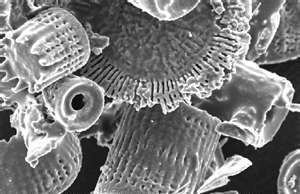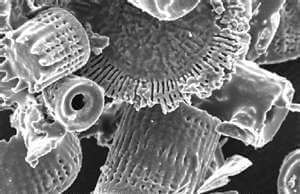Are there Beneficial Skeletons in Your Barn?
by Eleanor Blazer
Skeletal remains found in horse barn!
In many barns across the country skeletal remains of ancient microscopic single celled algae called diatoms may be found. When entering a barn that is known to harbor diatoms, the best place to find them is in the tack room. Look for a package that says diatomaceous earth or DE.

Millions of years ago the hard-shelled plants died – leaving behind remains, which consist of amorphous (without form) silica. Silica is a mineral and is beneficial to life. These massive deposits are mined and the “ore” sold to companies that market the product for various uses. Diatoms are mainly used for filtration. Because of its porous properties diatoms separate fine particles effectively. The ore is also used as an abrasive, as an absorption material, as insulation and in soil for moisture control.
So why is it sitting on the shelves of many horse barns?
Diatomaceous earth can be used as a non-chemical insecticide. When insects come in contact with DE the sharp particles damage the body and the dust dries them out causing dehydration. If the pests eat DE, it will damage the digestive system, also leading to death. Keep in mind it will also kill beneficial bugs. Many horse owners use it to dry out wet stalls and to fight the flies manure attracts. It is very absorbent; and detrimental to fly larvae.
The most controversial use of diatomaceous earth is as a dewormer. The theory is the sharp particles will kill intestinal worms. Unfortunately various studies at recognized research centers have not proven this to be true. Controlling intestinal worms in horses is a many layered endeavor. Rotating pastures, horse to acreage population, prior deworming history, age, closed stable versus a stable with new horses being introduced constantly, climate and season, manure management and type of parasite needing to be controlled requires a program designed for the stable or even the individual horse. Food grade diatomaceous earth will not harm your horse, but to rely on it as your only form of defense against intestinal worms is not wise.
Detractors of using this method of deworming think the volume and bulk of digesta in the equine digestive system protects the parasites from the sharp edges of the DE particles. As we never want to have an empty equine intestine, which can lead to twists and colic, trying to “fast” a horse before giving DE is not wise. The equine colon needs to be held in place by bulk. And the mucous membranes of the digestive system could be damaged by the sharp edges of the DE. There is also the question about what DE could do to a horse with ulcers or other digestive issues. I would not want to introduce particles with sharp edges to an already compromised digestive system.
Incorporating DE into a multi-faceted deworming program, which includes a bi-annual fecal flotation test, will not harm most horses. But it should not be your only means of defense against internal parasites. Consult your veterinarian. If you decide to add DE to your equine management program make sure you purchase a product labeled as food grade or medical grade. These forms will be free of any contaminants or unwanted additives. Avoid the crystalline form of silica, commonly used in swimming pool filters, as the beneficial properties have been changed and other chemicals may have been added.
These skeletal remains will not warrant a headline in your local newspaper, but they may aid in your war against parasites.
For information about caring for horses take the online course “Stable Management” taught by Eleanor Blazer. Earn certification or work toward a Bachelor of Science degree in equine studies.
Go to www.horsecoursesonline.com for more information.
Visit Eleanor’s web site at www.thewayofhorses.com.
Published April 2012 Issue

Eleanor Blazer was raised training and caring for horses. She learned to ride and care for the horses her family bought and sold. Many of these horses required improved nutrition when they arrived for training. Eleanor’s experience and research has benefited both horses and horse lovers in the field of equine nutrition. An equine nutrition consultant, based in Bulverde, Texas, she keeps busy doing equine nutrition consultations, conducting seminars, and speaking to youth groups about horse care and nutrition. Eleanor is the author of the syndicated column The Way of Horses. She has more than 20 years experience helping and being a mentor to those wanting to know how to provide the very best care and nutrition for our special friend – the horse.

